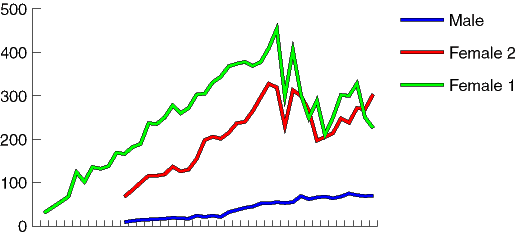 | mobile - desktop |
 | mobile - desktop |
 |
 Available Now at RodentPro.com! |
News & Events:
|
Captive Reproduction in the
African House Snake (Lamprophis fuliginosus)
|

|
This graph represents the monthly weights for three captive born and raised African House Snakes. These snakes were maintained on a feeding schedule of three small meals per month throughout most of the period. (Although this seems like very little feeding, I think it is probably more representative of their natural feeding patterns.)
The data for the females starts when they were at least 6 months old, for the male when he was hatched. The sudden drops in the weights of the females represent months were eggs were laid.
This graph clearly demonstrates the difference in adult size for females and males. You can also see the dramatic affect on the body condition that repeated breeding can have! The smaller female has never attained the size of the larger one, even when given a year off from breeding.
I am not trying to discourage anyone from breeding House Snakes! I am only trying to convey the facts about premature breeding of these often overanxious snakes!
Like most other colubrids, House Snakes lay eggs approximately two months after mating and the eggs take between 60 and 75 days to hatch. Females will usually stop feeding after the first month of gestation and will begin a shed cycle. After she sheds, she will lay her eggs within 5-10 days. I provide an secure (covered) egg-laying box of moist sphagnum or other material (see the picture at the top of the page where the female has laid in a container of moist Perlite) and the females will usually lay in there at night. If you don't provide a secure laying box, females will frequently lay eggs in the water bowl. Such eggs invariably die.
Frequently, there will be infertile eggs laid with the clutch of viable eggs. In the photo at the top, the brown egg is infertile and will not hatch. If it can be removed from the clutch, I remove it. If not, I just leave it attached.
The following table gives some of the relevant reproductive data for a pair of wild-caught adult House Snakes.
| Days from mating to egg-laying | Days from pre-laying shed to egg-laying | days to next clutch | Days incubation | hatch rate |
|---|---|---|---|---|
| 60 | - | 76 | - | 7/8 |
| - | - | (165)* | 83 | 6/7 |
| 59 | 7 | (107)* | 83 | 7/8 |
| - | 7 | 96 | - | (0/7)** |
| - | - | 93 | 72 | 8/8 |
| - | 9 | 65 | 77 | 11/11 |
| - | - | 73 | 67 | 12/12 |
| - | 6 | 80 | 70 | 10/11 |
| - | - | (260)* | - | (0/10)** |
| ~60 | 8 | 76 | 73 | 14/14 |
| (~129)^ | - | 69 | 76 | 8/8 |
| (~191)^ | - | - | 75 | 3/3 + 8 slugs |
| avg = 60.25 | avg = 7.4 | avg = 76.8 | avg = 75.2 | mean clutch = 9.5 |
- dashes represent unrecorded data
* = Snakes were separated between clutches. Not used in calculating mean values.
** = These eggs appeared healthy but were accidentally destroyed.
^ = These two clutches resulted from the previous mating. The adults were separated throughout the period.
I have noticed a significant difference in the clutch makeup in several of my female house snakes. I have bred one female for several years who laid 8-11 eggs per clutch. I have had another female who consistently laid 14-18 eggs per clutch. However, the clutch mass (the combined weight of the eggs) was the same for both females - i.e. one female laid a few large eggs while the other laid lots of small eggs. The large eggs produced big babies that fed readily while the small eggs produced frail little babies that were sometimes difficult to get to feed.
House Snake eggs are highly adhesive and the clutches are usually stuck firmly together. I make no attempt to separate them, even if there are some infertile eggs attached to the clutch.
House Snake eggs can be incubated like any other colubrid eggs. I use dampened vermiculite (I wet it and squeeze all the water out). I place the eggs on the surface of the vermiculite in a small deli cup or similar sized container. That cup is then place in a plastic sweater box that has a few centimeters of water standing in the bottom. I check the eggs a couple of times a week and open the container up if they are "sweating" or give them a spray with water if they are drying out (collapsing). My experience with House Snake eggs is that in the absence of some catastrophe, good eggs hatch.
You can build incubators for the eggs and incubate them at temperatures as high as 85°F (29°C), however, these temperatures are not necessary. I have found that any temperatures between 75°F and 85°F (24° to 29°C) are suitable. Temperatures above 85°F (29°C) may lead to increases in developmental deformities and decrease the hatch rate of the offspring. I have recently hatched a clutch of eggs that went through some low temps during development that produced 4 live snakes, three of which only had one eye. They are feeding and growing well in spite of missing the eye.
Hatchling house snakes vary from 6 to 10 inches in length. They usually shed within a week of hatching and then will be ready for their first meal. They should then accept one or two meals a week.
Hatchling House Snakes can be house successfully in relatively small containers. I have seen a few cases where hungry hatchlings have eaten their smaller brothers and sisters, so it is best to house them separately. This is especially true when feeding! Some hatchlings can be very aggressive feeders and will eat all the food offered and prevent the other, less aggressive snakes from getting any. It is also very dangerous to just throw a handful of pinkies into a cage with some hatchlings as one or two hatchlings may actually gorge themselves to the point that they can die. And even if you can avoid this catastrophe, house snake babies will invariably attack and try to swallow prey that other babies are already eating, resulting in one snake eating the other.
Hatchling house snakes will usually feed on previously frozen pink mice as soon as they have shed the first time. Occasionally I have a hatchling that refuses to feed at first. For these hatchlings I try the following steps:
Hatchling House Snake should be handled carefully for the first few weeks, as they are very excitable and prone to diving out of their cages or your hands!
| Home | Natural History | Captive Care | Feeding | Reproduction | Photo Gallery |
 |
New & Updated Business Listings